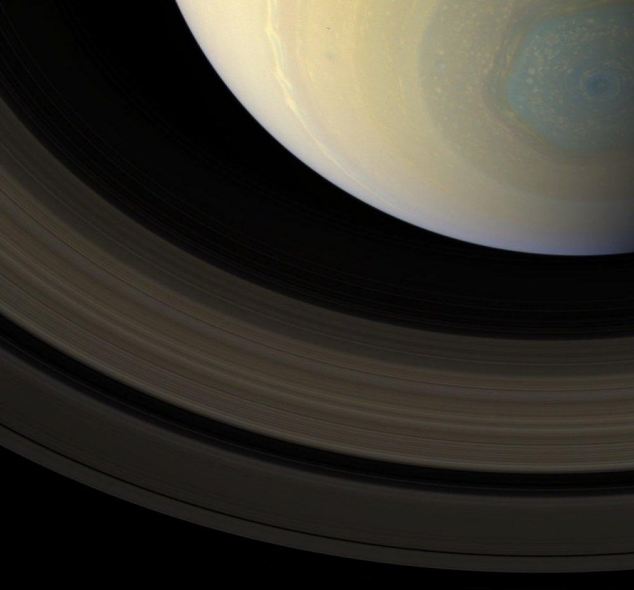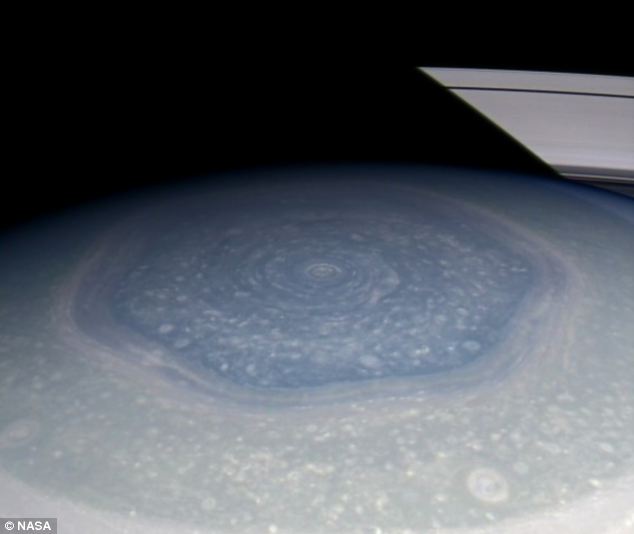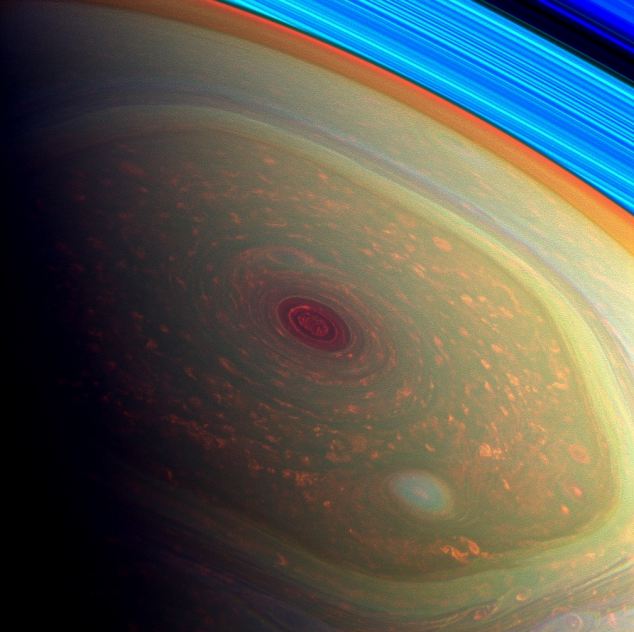- Hexagon shape is created by a band of upper-atmospheric winds on Saturn
- Images, up until now, have shown it in false-colour infrared wavelengths
- In April, the Cassini spacecraft provided scientists with the first close-up views of a behemoth hurricane swirling within it

But up until now, images taken of it have been in infrared wavelengths, showing false-colour shades of red, orange and green.
Now Nasa's Cassini spacecraft, which has been orbiting the planet for over nine years, has captured the northern hexagon in its true, incredible colours.
The hexagon is nearly 15,000 miles (25,000 kilometers) across - big enough for nearly four Earths to fit inside.
The colour composite below has been created from raw images taken by Cassini from a distance of 379,268 miles away.
It shows the strange geometric structure of the hexagon alongside the impressive variation in shades around Saturn's northern hemisphere.

First seen by Voyagers 1 and 2 over 30 years ago the hexagon it thought to be fixed with Saturn's rotation.
In April, the Cassini spacecraft provided scientists with the first close-up, visible-light views of a behemoth hurricane swirling within the hexagon.
Thin, bright clouds at the outer edge of the hurricane were estimated to be travelling at around 330 mph (150 meters per second).
'We did a double take when we saw this vortex because it looks so much like a hurricane on Earth,' said Andrew Ingersoll, a Cassini imaging team member at the California Institute of Technology in Pasadena.
'But there it is at Saturn, on a much larger scale, and it is somehow getting by on the small amounts of water vapor in Saturn's hydrogen atmosphere.'

Although there is no body of water close to these clouds high in Saturn's atmosphere, learning how these Saturnian storms use water vapor could tell scientists more about how terrestrial hurricanes are generated and sustained.
Both a terrestrial hurricane and Saturn's north polar vortex have a central eye with no clouds or very low clouds.
Other similar features include high clouds forming an eye wall, other high clouds spiraling around the eye, and a counter-clockwise spin in the northern hemisphere.
A major difference between the hurricanes is that the one on Saturn is much bigger than its counterparts on Earth and spins surprisingly fast.
At Saturn, the wind in the eye wall blows more than four times faster than hurricane-force winds on Earth.
SATURN'S HEXAGONAL VORTEX
The mysterious six-sided hexagon on Saturn's North Pole has long captivated astronomers is thought to be is nearly 15,000 miles (25,000 kilometers) across .
The hexagon is made of a band of upper-atmospheric winds which creates its six-sided shape. A polar cyclone can be seen at its centre.
First seen by Voyagers 1 and 2 over 30 years ago the hexagon it thought to be fixed with Saturn's rotation.
In April, the Cassini spacecraft provided scientists with the first close-up, visible-light views of a behemoth hurricane swirling within the hexagon.
Thin, bright clouds at the outer edge of the hurricane were estimated to be travelling at around 330 mph (150 meters per second).



Hmmm..-maybe this is the 3D view of inter dimensional/density portal. The Hexagon shape is so odd..